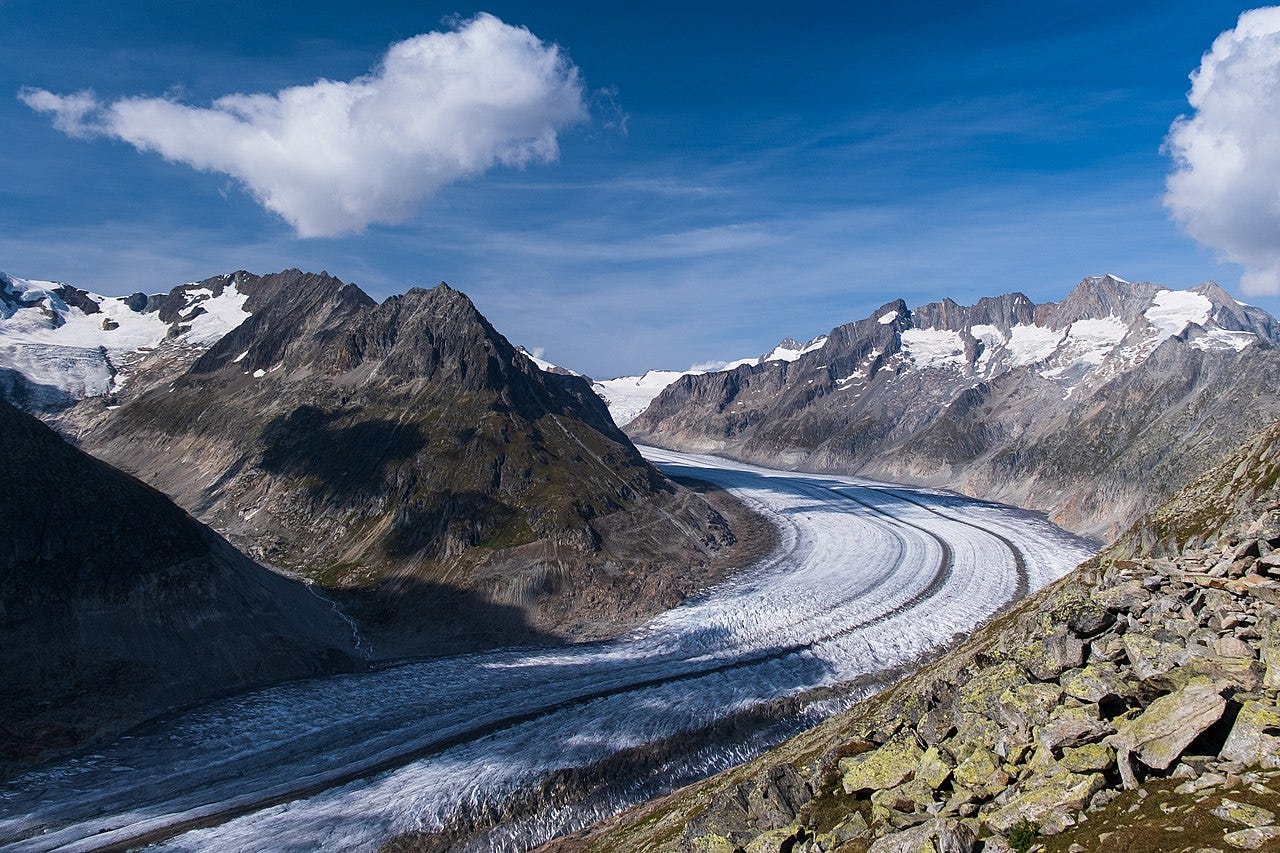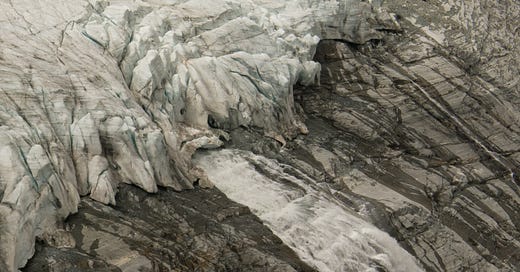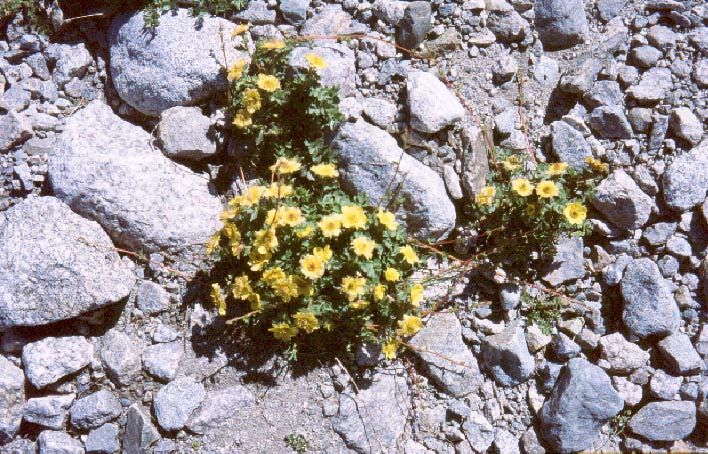We arrived in the Alps already tired after hitch-hiking right across France carrying large, heavy rucksacks with iceaxes strapped to the outside. We walked up under the cablecar (riding up in cablecars costs money) to the meadows of Bel Alp, and found a quiet spot among some glacier moraines to put up our tent. Then we started climbing.
First off, we tried something called the Nadelhorn (around 3000m). There was soft snow, low cloud, and quite a lot of crevasses. Even though we turned back 150 metres below the top, this still came to a 12-hour day on the hill.
Two days later, we decided to have a go at the Unterbächhorn. A rocky ridge, not terribly good rock but one interesting bit, a reddish tower at around Severe grade. After five or six hours, we still hadn’t got to the interesting bit. After seven hours, we got to the top – still without having got to the interesting bit. This was because what we’d got to the top of wasn’t the Unterbächhorn. it was a different and somewhat smaller mountain called the Gissighorn.1

That was another 12-hour day. With an extra half-hour of rambling about added to the end of it when, after a luxurious glass of BEER, I lost track of David in the dark and also lost track of where the tent was among the little moraine humps…
Two twelve hour days was a good solid start. After that we decided on an easy one. A simple stroll up the glacier, for a couple of nights at the mountain hut just above the head of it: the Konkordia Hütte so perfectly placed among a clump of 4000m mountains.2
Just one thing. The glacier in question is the biggest in Europe: the 23km of the Great Aletsch Glacier. All of it. With full climbing gear and three days food in the rucksack. Why ever not?
The odd thing about a glacier is its ugliness. Not the upper glacier, where it's snow-covered and just looks like snow with a few funny cracks running across it. But the lower glacier, the dry glacier as it's called, where the ice is bare.
But even before the glacier, there’s the moraine. Up at its top end, the glacier’s gouged a great crag-sided channel out of into the landscape. The crags, naturally enough, drop stones and boulders onto the edge of the glacier. So that when the ice moves downhill to where you can get onto it – well, that getting onto it is over a big loose pile of boulders and stones. The glacier-ground-down rock dust and gravel eventually collect a little soil around them: at the edge of the moraine, there are often some pretty wildflowers. Not really set off by the background of stones and boulders and dirty grey ice…
Ice should be cold. The dry glacier, after you spent half the day walking uphill to reach it, is hot under the afternoon sun. Ice should be sparkly. The dry glacier is dirty grey, with stones lying around all over.
The dry glacier, above all, ought to be dry. In fact, under the afternoon sun, it runs with water. Little streams babble along between banks of ice. Those banks are rounded like underground limestone, but forming and reforming in hours rather then geological ages. The streams holds ice particles, and particles of grit, and are dirty grey like the ice they run through.
Wet feet and stream crossings can be a bit of a problem. Crossing the unstable rubble to get onto the ice was a problem. But the main problem is the crevasses. Ice is very solid. Where it goes round a bend, it cracks on the outer side of the curve. Where it hauls itself over a hump, it cracks right across. And where it comes to a steepening, it breaks into chunks, from house-size to airport-terminal size, and falls over the edge one chunk at a time.
The beauty lies in the detail. Stream comes to a crevasse and falls in: the hole gets worn by falling water, but also shrunk down by refrozen splashes, and so forms a twisty curve like your intestine would be if you happened to be a snowman with innards made of ice. Down inside the glacier the stream chuckles and shouts: it’s called ‘moulin de glacier’ or glacier waterwheel.
Again, water gathers in a pothole pool. The pool is circular, and expands below the surface like a green eye. It's the ‘marmite de glacier’, the ice-cauldron. I could say that some people love them and some hate them, but that (of course) is the Marmite that comes in a brown glass pot – because that sort of marmite is also named after the French for a cauldron, and even has a picture of one on the label.
Jump across a crevasse, head off sideways to get around the next one, and a boulder stands high above the glacier, on a toadstool stalk of ice – ice that the boulder itself has protected from the sun. That’s a glacier table. But don’t eat your Marmite sandwiches off it as it’s liable to drop off its icy leg and onto your toes.
The crevasses: green in their depths, blue in their even deeper depths, and a sudden chill from below as you leap across in your crampons. Two crevasses converge, leaving a blade of carious sun-shrunken ice: very pretty, unless you were trying to cross the glacier along the strip of ice between those two particular crevasses.

From above, the glacier looked like a wide smooth road running up among the mountains. It’s even got road markings: grey stony stripes of moraine running down the middle. Because where two side-glaciers join together, each of them has piles of edge moraine running along its edges; so where they join, the two edge moraines combine into one big moraine running down the middle. Which makes it exactly like the lane divider on the motorway, the one where if you keep to the right-hand lane you’ll get carried into the slip-road running off up the Ewigschneefald tributary glacier, the turnoff for the Grünhorn and the Eiger.
But when you're down there on that glacier, it's a road of sorts, but one supplied with booby traps, toll booths, and site-specific sculpture.
At the end of the afternoon we come to the Konkordiaplatz, a wide glacier bowl at the meeting of three icefields, named after the Place de la Concorde in Paris. A short climb up ice-smoothed rocks – because even then in 1971, the glacier has been shrinking downwards away from the hut. A short day out, yes: just ten hours this time, trekking up the glacier.

The Swiss monitoring body GLAMOS (GLAcier MOnitoring Switzerland) calculates that the Swiss glaciers have in 2024 lost 2.5% of their total ice. And 2024 has been a good year, after an unusually snowy winter and cool spring. In 2023 it was 4%. In 2022 it was 6%.
According to this article on Swissinfo.ch, some (unnamed) researchers suggest that within the next 30 years the Aletsch Glacier will be completely gone. However, others are more hopeful. It might even survive to the end of this century.

Years later, I read in ‘A Progress in Mountaineering’ (1950) an account of JHB Bell climbing above Bel Alp with ‘Turnbull’ in 1936: the Turnbull in question being my Grandpa. They climbed both the Gissighorn and the Unterbächhorn; then set out for the first ascent of No. 8 of the Fusshörner, but actually climbed No. 11… So it seems this Gissighorn thing may be genetically determined.
The Konkordia hut has access to the Aletschhorn, the Jungfrau, the Mönch, the Grosses Fiescherhorn and the Grünhorn. Or you can trek across the ice to the Jungfraujoch station and take the train down to Grindelwald.









Glaciers! Hmmm... sometimes beautiful, sometimes ugly, almost always dodgy! The first one I ever saw and subsequently set foot on was in South Georgia in winter 1958. Innocence is bliss. Descending from a minor summit, it swallowed me into its bergschrund, the abyss below looking bottomless. Which was disconcerting as nobody knew I was there. So needs must. After a grim struggle I emerged, trouser backside and much of mine in shreds - but I lived to tell the tale unlike Ötzi, who lived sometime between 3350 and 3105 BC. His remains were discovered frozen in ice in 1991, in the Ötztal Alps on the Austria–Italy border..
All very true. And when you spend not ten hours but three weeks on glaciers, with occasional relief on moraine terraces, you really get to know how non-uniform they are (Biafo—Snow Lake—Hispar).